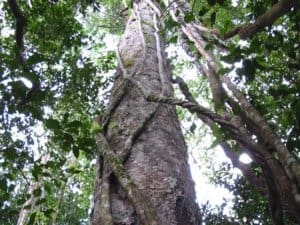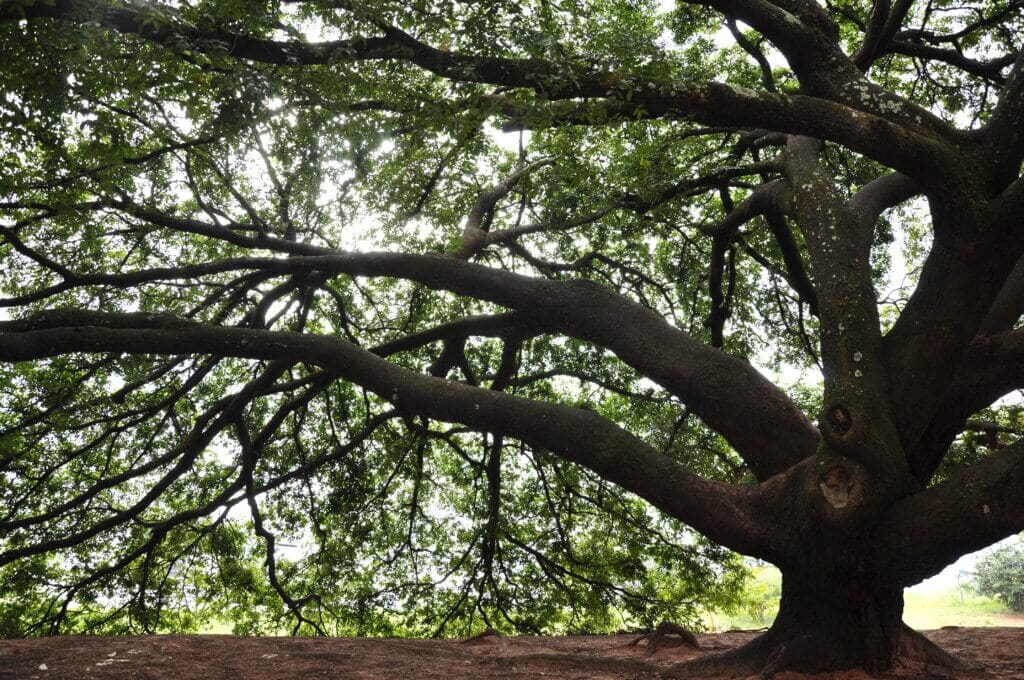What is Copaiba?
Copaiba is harvested as an oleoresin from the copaifera tree. According to the National Center for Biotechnology Information, approximately 72 species of copaifera plants have been identified worldwide, with 20 of those in existence in Brazil alone.2 The primary species of copaifera growing in the Amazonian rainforest is C. reticulata. In fact, C. reticulata is the source of 70% of the production of Copaiba oleoresins.
 Copaifera trees stand dignified in the rainforest. Each tree can grow to a height of 120 feet and boast a diameter of 12 feet. These trees grow slowly and live for an impressive 400 years. Often one hectare of land will only contain one or two of these trees, as they prefer low dense environments.
Copaifera trees stand dignified in the rainforest. Each tree can grow to a height of 120 feet and boast a diameter of 12 feet. These trees grow slowly and live for an impressive 400 years. Often one hectare of land will only contain one or two of these trees, as they prefer low dense environments.
The copaiba oleoresin accumulates in the trunk of the tree. Harvesting involves Scoring and tapping the tree-like maple syrup, or puncturing the bark layer, and inserting a small tube so the oleoresin can run free into a cup or a jug. The oleoresin is then collected and combined with oleoresin from multiple trees for storage in five-gallon food-grade jugs which we prepare for delivery to our lab for testing and processing. One copaifera tree typically produces between 100mL and 60L of oleoresin in a year.3
What makes Copaiba a popular for system restoration?

 Copaifera trees stand dignified in the rainforest. Each tree can grow to a height of 120 feet and boast a diameter of 12 feet. These trees grow slowly and live for an impressive 400 years. Often one hectare of land will only contain one or two of these trees, as they prefer low dense environments.
Copaifera trees stand dignified in the rainforest. Each tree can grow to a height of 120 feet and boast a diameter of 12 feet. These trees grow slowly and live for an impressive 400 years. Often one hectare of land will only contain one or two of these trees, as they prefer low dense environments. A primary reason copaiba oleoresin has been sought for centuries for a multitude of benefits is because of the high amounts of β-Caryophyllene it contains. β-Caryophyllene is a sesquiterpene--a material found in botanicals that provides the plant with a unique taste or smell. β-Caryophyllene happens to be the same sesquiterpene that provides pepper with its spicy flavor; however, its benefits have nothing to do with taste!
A primary reason copaiba oleoresin has been sought for centuries for a multitude of benefits is because of the high amounts of β-Caryophyllene it contains. β-Caryophyllene is a sesquiterpene--a material found in botanicals that provides the plant with a unique taste or smell. β-Caryophyllene happens to be the same sesquiterpene that provides pepper with its spicy flavor; however, its benefits have nothing to do with taste!